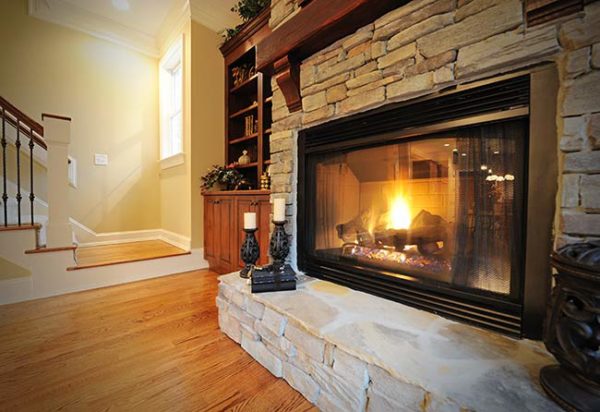Enjoy the warmth of a fire with the flick of a switch when you convert your wood-burning fireplace by installing a gas fireplace insert. A gas fireplace can provide efficient warmth and ambiance without the additional work associated with wood burning. Installing fireplace inserts is a convenient way to add the modern efficiency of gas fireplaces to your home’s existing firebox.
Why Choose a Gas Fireplace Insert?
#1. Energy Efficiency
One of the bigger upsides to installing a gas fireplace insert is the energy efficiency. If you spend most of your home life in a particular room of the house, using a gas fireplace to heat just that room will save you a significant sum in the long run versus turning the thermostat up. It’s called zone heating and it means spending a little on your gas fireplace to save a lot by not heating your whole house for no reason!
If you use your fireplace to heat your home, gas fireplaces offer some advantages over wood-burning fireplaces. For one, gas fireplaces lose far less heat compared to their wood-burning counterparts. This allows you to heat your room more quickly and efficiently. Feel free to take a big, deep breath too – burning natural gas versus wood also improves the air quality in your home! It’s a great benefit for those with respiratory issues or allergies.
#2. Convenience – Both Before & After
If you’re a wood-burning fireplace pro, you may have your own special technique for getting a roaring fire going in seconds… but you’ll never be faster than a push-button starter. Being able to get your fireplace going with no work – and without leaving your couch – can make a big difference during those cold winter months. And there’s no trick to controlling the flame itself, simply adjust the variable flame control and you’re all set.
With traditional wood-burning fireplaces, you also need to worry about cleanup after every use. Burning wood logs leaves the obvious ash and soot, but you also need to be aware of creosote buildup. Burning natural gas doesn’t leave the same residue, so it is much easier to maintain between annual professional inspections.
#3. Easier & Lower-Cost Maintenance
A gas fireplace doesn’t have much to handle in terms of regular maintenance, outside of the standard yearly inspections that all fireplaces need to keep you safe. If all appears to be operating correctly, you’ll mostly just want to make sure it’s clear of dust that may have collected inside and around any components. If you live in a temperate climate, this can generally be done just around the start of the cold weather season. Of course, you’ll also want to clean off the screen too!
Other Types of Gas Fireplaces
If a gas insert fireplace isn’t exactly what you’re looking for, you have the option of using gas logs instead. These synthetic logs are visually similar to real wood and help keep your fireplace looking authentic and traditional. There are two primary types of gas logs available:
Vented gas logs are a more budget-conscious option that offer many of the upsides of a fireplace without the hassles. Installation costs can be lower, and these logs produce a beautiful visual that looks like real wood fire. The downside? Since the damper must be left open to use these, much of the heat they produce is lost, so they’re not nearly as effective for heating versus other options.
Ventless gas logs are like other gas logs, but do not require a chimney or flue. Easy to install and relatively inexpensive, ventless gas logs may be a good option for heating a room in your home. Since there’s no vent for heat to escape, all the heat stays in the room.
That’s not to say ventless gas logs come without their drawbacks. There is the potential for health risk with these, and they may cause issues for individuals with respiratory concerns. You also should know that ventless gas logs release carbon monoxide, although the amount is well below the threshold for concern. We have more information about ventless gas fireplaces here, or read our recent article to learn about the best types of gas logs for your fireplace.
The Cost to Convert a Wood-Burning Fireplace to Gas
Converting your wood-burning fireplace to gas can range in cost depending both on the type of fireplace you choose, as well as the specific gas logs or insert you choose. In general, expect to budget between $500 - $3,600.
Start with finding the gas fireplace or gas log option that works best for your home. There are multiple models to choose from:
Remember that fireplace safety is important! It’s best to leave installation of a gas fireplace to the experts. If you’re in the Michigan or Ohio areas, contact us for more information about our fireplace installation services.
Maintenance for Your Fireplace
Once your new gas fireplace is installed, all that’s left isthe maintenance. Like we mentioned earlier, you can save a lot of time in maintenance with these types of fireplaces. That said, it’s just as important, if not more so, to keep them working properly and safely. Making sure you know how often to clean your chimney is key to preventing bigger problems from happening.
Of course, we’re moving into the warmer season now, but don’t plan to wait until fall or winter for have your fireplace serviced! We have 3 great reasons to complete your gas fireplace maintenance before the winter.
Schedule an Appointment
Doctor Flue can help you with your gas insert installation and maintenance! Request a quote or simply call and talk to our helpful staff for more information. We look forward to working with you.
Call Us: 1-800-438-3583
Email Us: office@drflue.com
Office Hours: Mon-Fri: 8am-4pm



